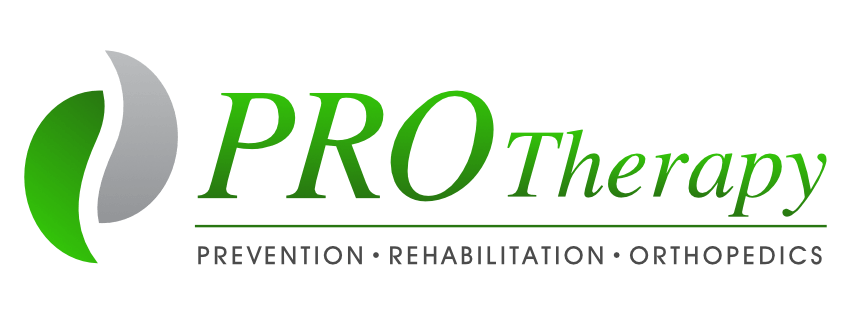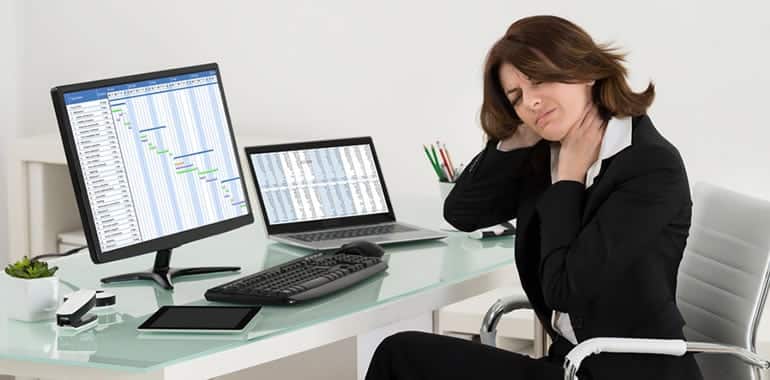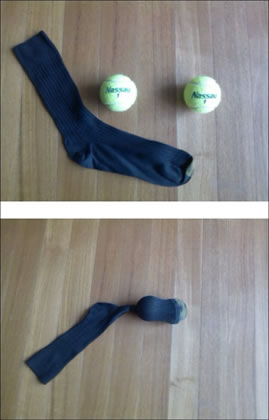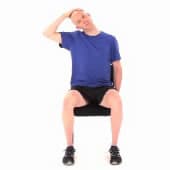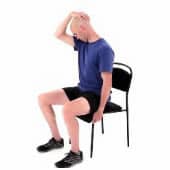If you work at a desk – whether in the office or at home – chances are you’ve experienced neck pain.
Almost half of desk workers report having discomfort or pain in their neck at some point. This pain can lead to decreased work production, diminished work satisfaction, and overall decline in quality of life. Unfortunately, the pain can continue to persist and recur periodically through your working life.
The reality is, most of us are unaware of how to manage the pain, or even know how to prevent the neck pain from occurring. We may take over-the-counter pain medication to relieve the pain knowing that the same pain will likely return the next day at work. This causes us to believe we have two options: quit our job or live with the pain.
The goal of this article is to address the possible causes of your neck pain.
Beyond the basics that we will walk through, as movement experts, we will provide you with some simple exercises to help not only manage your pain but prevent the pain from returning. By the end of the article, you’ll understand that you have more than the limited two options when dealing with neck pain.
What Causes Neck Pain?
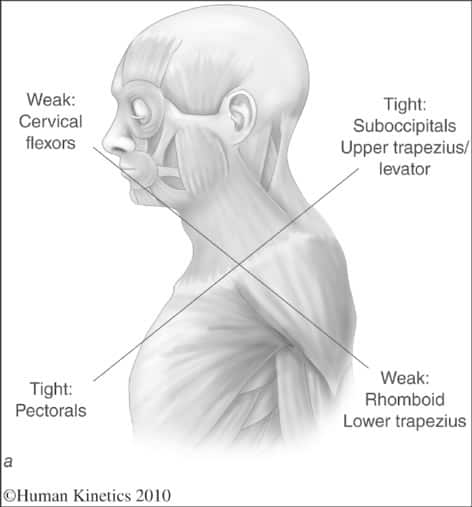
First – in order to understand why our neck is hurting, we need to look to the likely source.
Most likely, your biggest problem is the most common there is, your desk/workstation. If you spend almost half of your day at a desk or workstation, then you want to make sure it’s set up correctly. Incorrect setup can lead to what is called Upper Crossed Syndrome (UCS).
UCS is a term used to describe a posture where the head is positioned forward as well as shoulders rounded forward. As you can see from the image above, what causes this position is muscles that are weak, tight, or both. Being in a prolonged position with the head forward and shoulders rounded, like what most people do when using their computers or cell phones, results in these characteristics. The muscles on the front of the neck and back of the shoulders are weak whereas the muscles on the back of the neck and front of the shoulders are tight.
This can result in not only neck pain, but headaches, shoulder pain, or pain shooting down the entire arm due to the strain it puts on the neck and shoulders.
Not everyone who has neck pain with a desk job may be dealing with every aspect of UCS, but chances are you are dealing with some characteristics of UCS. Therefore, looking at the correct posture and ergonomics of your workspace can help maintain as well as prevent neck pain.
How to Setup Your Workspace to Avoid Neck Pain
When looking at your workspace to prevent neck pain, be mindful of head and shoulder positioning for the following items:
Your Computer Screen
The best screen to help with head positioning is a large monitor that is set up with the very top of the monitor at eye level and slight backwards tilt of the screen.
If you are only allowed to use a laptop, you can purchase laptop stands to get the laptop to the correct eye level. Looking for larger screen laptops helps as well!
Your Desktop Setup
When setting up your workspace, be mindful of what objects you use most often – which for most people are their computers. These objects should be placed in the center of your desk for less prolonged rotation of your neck. The rest of your items should be placed within reaching distance. Those objects can be rotated every so often to prevent overuse of one side.
Tip – if your phone is on the right side of your desk, you can move it to the left side of your desk after a week to prevent reaching to the right side all the time!
➡ Related Content: Physical Therapy for Text Neck
Your Chair
Your chair height should be positioned so your feet are flat on the ground with your knees at a 90-degree angle. Make sure you are sitting close enough to your desk so that your wrists are comfortably resting on the desk while using the keyboard.
While sitting in your chair, you should have a back rest that allows for a comfortable, erect spine without slouching. Your arm rests should be high enough to comfortably rest your elbows on and allow for your shoulders to be relaxed.
Additional Tips
Standing desks or stability balls can be beneficial to switch positions and keep your muscles activated and engaged. Likewise, perfect posture all the time is hard to attain and can cause its own problems. The best position is your next position. Change your posture often and take note of when you are tensing the muscles in your shoulders and neck.
Most people hold their stress in their shoulders by raising their shoulders toward their ears which can result in unnecessary tension and pain that occur in the neck. Simply reminding yourself to relax your shoulders can make a world of difference!
How to Manage your Neck Pain
There are two main ways to combat neck pain from UCS: mobility and strengthening. Below we will go through the importance of both mobility and strength as well as give you a few exercises to start helping manage your pain.
1. Mobility
Movement plays a big role in reducing pain.
Gentle movements can help reduce tension in muscles/tissues and bring blood flow for healing which both reduce pain. Below are some exercises to help improve mobility in your neck.
Neck Foam Rolling
You can either order a peanut foam roller or what we like to do is take two tennis balls and place them in a sock tying a knot in the end, so they don’t fall out.
Next while laying on your back place the peanut at the base of your skull and gently move your head up and down like you’re shaking your head yes. You can do this for a minute or so and then switch to shaking your head no.
Open Books
Lay on your side with your head resting on a pillow. Bring your knees up as high as they can go. Next stretch your arms out so they are perpendicular to your body. Keep the bottom arm down as you bring the other arm up and over to your other side. Keep your head in line with the top arm to get rotation in your neck. Then repeat 20 times, each time trying to stretch a little further. Then perform on the other side.
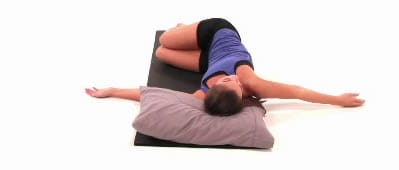
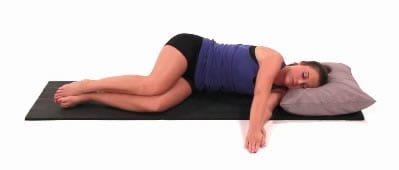
Upper Trapezius Stretch 1
In a sitting position, tilt your head to one side keeping the opposite shoulder down. Tilt your head to the point where you feel a stretch. Proceed to hold in this position for 30 seconds. Repeat on the other side as necessary.
Upper Trapezius Stretch 2
In a sitting position lower your head so your nose is in line with one armpit. Proceed to lower your nose, keeping the opposite shoulder down, until you feel a stretch. Hold for 30 seconds. Repeat on the other side as necessary.
2. Strengthening
With UCS we have weak muscles that limit neck stability which can contribute to pain. To combat this, we need to strengthen specifically the muscles on the front of the neck and the muscles on the back of the shoulders. Below are some examples to help you start strengthening those muscles.
Chin Tucks

Laying down on your back, draw your chin and back of your head straight down into the surface you are laying on. Think about trying to make a double chin. Hold this for 5 seconds and then repeat 10-15 times.
Scapular Rows
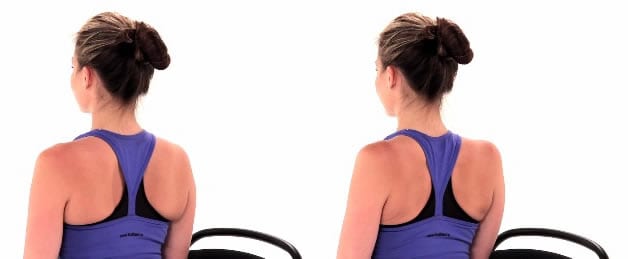
While sitting, try to pinch your shoulders slightly together and down. Hold this position for 5 seconds and then repeat 10-15 times.
- Can I Have Physical Therapy for Arthritis? - December 5, 2024
- Rehabilitation for a Car Accident- Recover PRO Therapy - November 26, 2024
- MVA Post-Surgery Rehabilitation - November 18, 2024
